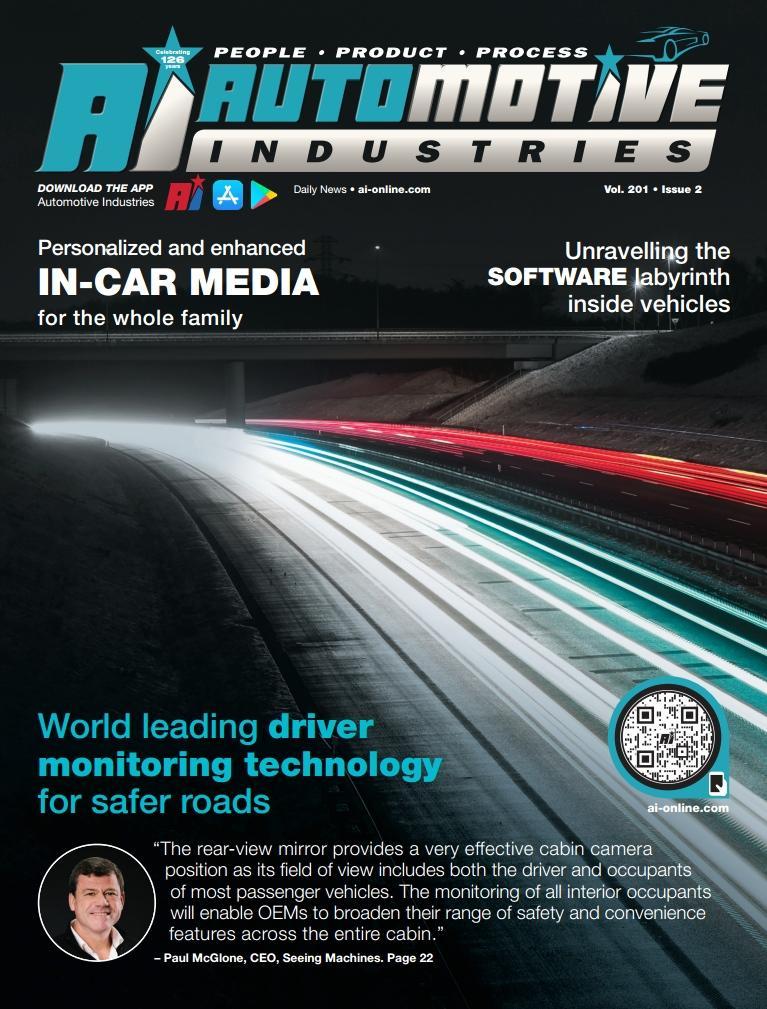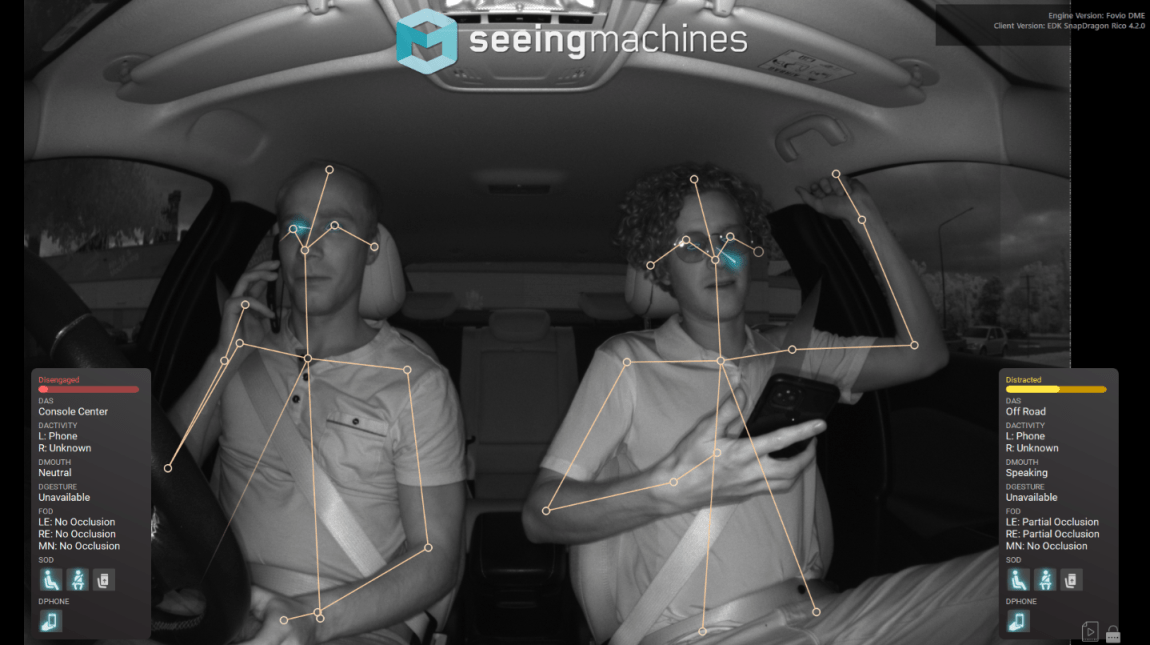
Driver and passenger monitoring system development has been given a boost through a partnership between two of the industry leaders.
Seeing Machines and Magna have signed an agreement to exclusively co-market driver and occupant monitoring systems targeting the interior rear-view mirror.
It combines the strengths of Seeing Machines, an advanced computer vision technology company that designs AI-powered operator monitoring systems to improve transport safety with Magna, a global mobility technology company.
In terms of the agreement, Magna will invest US$65 m into Seeing Machines through a combination of cash and a convertible note.
Automotive Industries (AI) asked Paul McGlone, CEO, Seeing Machines, what the benefits are to the OEMs and Tier customers of the collaboration.

McGlone: Successfully integrating driver and occupant monitoring into the rear-view mirror is very challenging technically. Working closely with the team at Magna, we have managed to do this and it’s an industry first.
AI: Why the rear-view mirror?
McGlone: We see it as a – if not the – key location for driver and occupant monitoring system technology.
It addresses a few key challenges for OEMs, and provides a seamless package across a diverse line of vehicle models, enabling compliance with Euro NCAP and other regulatory standards associated with driver distraction and impairment. This solution also addresses the issue of increasing electronics and cost.
The rear-view mirror provides a very effective cabin camera position as its field of view includes both the driver and occupants of most passenger vehicles. The monitoring of all interior occupants will enable OEMs to broaden their range of safety and convenience features across the entire cabin.
AI: Where is the funding for this R&D coming from?
McGlone: While regulation can drive DMS fitment volume, “feature wars” will drive OEM system value and Seeing Machines average selling price (ASP). As one of the leading technology and solution providers in the global DMS sector, we believe this to be a key inflection point for our business.
The balance sheet strength of the exclusive license payment and investment will fund our current business plan and the investment in our technology and intrinsic company expansion that will be required to meet this expanding demand.

Similarly, we will seek to strengthen our technology leadership position in the market. Seeing Machines has its FOVIO chip-based solution that is high performing and able to meet standardized (mass-market) demand.
Additional R&D investment is now necessary to maintain and enhance our leadership position by delivering a next generation standardized technology offering to the mass market, in support of expected technology protocols recently released by Euro NCAP.
We would also consider a number of niche technology strategic collaborations to support acceleration of an expanding feature set.
AI: When will the technology be commercialized?
McGlone: Seeing Machines and Magna are already working together on automotive OEM programs which are expected to start production from early 2024.
Further, together with Magna, we announced in April 2022 the launch of a demonstrator that features a fully integrated DMS combining camera, electronics and interior mirror technology.
The demonstrator combines Magna’s mirror technology, camera design, integration, and packaging know-how, with Seeing Machines approach to optimized and co-designed optical path, embedded processing, and enhanced AI vision algorithms for DMS.
AI: What next for the partnership?
McGlone: We will work closely with Magna to develop the market for driver and occupant monitoring system technology, integrated into the rear-view mirror. That will be the focus until 2025. Obviously, Magna is already invested in the company and that signals interest in our future.
Together, we will pursue opportunities that would mutually benefit our businesses and continue to collaborate at all levels to achieve our goal of enhanced safety on roads.
AI: How does the path to full autonomy affect the need for DMS?
McGlone: The dynamic within the industry, in many ways, has been driven by the path to full autonomy which has focused most of the industry’s energy and resources towards sensing what is going on outside of the vehicle.
But it’s the integration of internal cabin sensing technologies, understanding what the driver is or is not doing, that are making huge strides in safety and will ultimately achieve a zero accidents future.
Early driving ‘assistance’ features, for example the automotive transmission or cruise control system, have evolved and become known as Advanced Driver Assistance Systems (ADAS).
The emergence of ADAS and external sensing technologies, such as Traffic Sign Recognition, Lane Departure Warning and Blind Spot Detection are now familiar to most of us. Recognizing that drivers are prone to error, safety technology providers are taking a systems approach to assist, enhance and even handle the driving task.

Signals provided by the driver monitoring system could and will provide information that allows for safer and more complex decisions about when and how to intervene in a potential collision.
AI: Any final comments about what’s happening at Seeing Machines?
McGlone: A definite advantage of the collaboration with Magna is that, through access to the convertible note funding, our balance sheet is significantly strengthened, and this really does set us apart in our industry.
Developing a new technology, like driver monitoring system technology, takes many years of R&D and the ability to lead the industry with new features that OEMs are looking for, in order to enhance the safety technology and provide convenience options, is something that we are now able to continue to focus on.
The work we have done with regulators and government bodies around the world has helped establish DMS as a key enabling technology for the foreseeable future and this is set to extend beyond Europe and China, to the USA and eventually, everywhere around the world.
More generally, over the past year we have been appointed to six additional automotive programs, bringing our OEM count to 10 across 15 expanding programs. We have also received our first award from the Japanese market.
We also have an aftermarket and aviation business, both of which are also progressing well, and we think that the future is definitely a bright one for driver and occupant monitoring systems and Seeing Machines is at the forefront of the industry.
 New FOVIO rollout
New FOVIO rollout
Seeing Machines has been appointed by an existing Tier-1 customer to deliver its FOVIO Driver and Occupant Monitoring System (DMS/OMS) for an additional program with an existing large European-based global automotive group (OEM) customer.
This program, to be delivered via Seeing Machines’ embedded Driver Monitoring Engine (FOVIO e-DME software library), is geared to lower integration cost and will substantially extend DMS and OMS reach across a broad range of vehicle models (including entry level vehicles), while addressing both regulatory requirements and in-cabin comfort and convenience oriented features. The program carries an initial lifetime value of US$32M (A$45M) and is scheduled to start production in 2024.
“This is a great example of our existing Tier 1 and OEM relationships and cooperation leading to the increasingly extended reach of our technology across the global passenger vehicle landscape, which is not only driven by driver safety regulation but also an increasing demand for interior monitoring systems extending the comfort, convenience, and safety of all vehicle occupants,” says Nick DiFiore, SVP and GM Automotive.











More Stories
Automotive Industries interview with Johannes Mark, Head of Global Parking Insights, EasyPark Group – Transforming Urban Parking with Light Detection and Ranging Technology
How Secure Parking Technology is Shaping the Future of Urban Development
Click Shield from MIKROE simplifies integration of Arduino Portenta with over 1600 Click boards